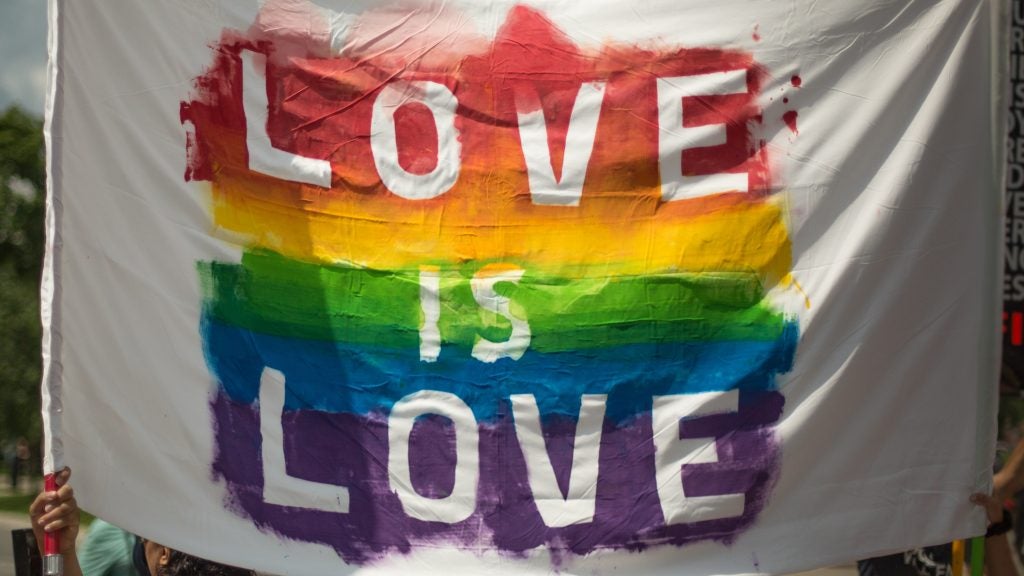
Before coming out, one has to come to terms with their own sexuality. Though it may be difficult to fully comprehend at the time, sexual identity formation almost always occurs in a predictable progression from some sort of awareness of same gender attractions and feelings, to the total incorporation of the new identity into the total sense of self. The following model is one way in which the progression of same-gender sexual identity formation occurs. This model is not inclusive of every same-gender sexual identity formation experience but can serve as a framework to help understand the process. The model is not specific to any age because individuals experience these stages at different ages depending on maturational and social factors. While these stages are sequential, some people might revisit stages at different points in their lives.
The Cass Identity Model
Stage 1: Identity Confusion
This stage occurs when an individual begins to realize that information about same-gender sexual orientation relates to them. This stage is marked by a sense of confusion, as individuals experience cognitive dissonance between their old sexual identity and new one. Individuals may have dreams or fantasies about the same gender, and may attempt to avoid sexual activity entirely. Individuals may begin to question their sexual identity, asking themselves, “Could I be gay/lesbian/bisexual/trans, etc?” This questioning moves individuals towards the second stage of the model.
Stage 2: Identity Comparison
During this stage, individuals begin to examine the larger implications of identifying as a member of the LGBTQ community. They begin to gradually give up heteronormative behaviors; one may feel a sense of loss and grieving may occur. Some individuals may still try to behave as heterosexuals, as they may not be prepared to deal with possible negative confrontations over their sexual orientation. Some may even turn their own confusion into anti-gay attitudes and exaggerated heterosexual behavior. However, the Identity Comparison stage can have positive implications, as individuals embrace their newfound identities and devalue the importance of heterosexuality in their lives.
Stage 3: Identity Tolerance
This stage is categorized by an increased commitment to and tolerance for their new identity, as individuals accept themselves as a member of the LGBTQ community and begin to recognize their newfound sexual, social, and emotional needs. Individuals increase their contact with others in the gay community, which can serve as a forum for them to ease into their identity, as well as a place to meet romantic partners and positive role models. This stage can be difficult for those who are shy, have lower self-esteem, lack social skills, and fear having their sexual identity known by others. Individuals who have mostly negative experiences during this phase may never progress beyond it and may never tell anyone about their sexual identity1.

Stage 4: Identity Acceptance
This stage occurs when individuals recognize and accept their sexual identity, rather than simply tolerating it. There is increased shared contact with the LGBTQ community, which can positively influence the attitudes of the individual. The attitudes and lifestyles of other members in the community can play a significant role in determining how comfortable one becomes expressing their own identity.
Stage 5: Identity Pride
At this point, individuals identify strongly with the LGBTQ community, and their pride in the accomplishments of the community deepens. Individuals are less likely to judge themselves against heterosexual norms, and as efforts to hide their sexual identity are increasingly abandoned. Some individuals may even begin to campaign for gay rights. This stage is also a common time in which individuals “come out” to their friends and family. Coming out to parents is one of the greatest challenges during the identity formation process, because many fear negative reactions. Whether or not individuals move to the final stage of the identity formation process is determined by the reactions of those they come out to, as they may confirm the notion that heterosexuals represent the opposition in the fight for gay rights. If you are interested in reading more about the process of coming out, please click here.
Step 6: Identity Synthesis
In the final stage of identity formation, individuals realize that the world is not divided based on sexuality. Not all heterosexual individuals are bad, and not all homosexuals are necessarily good. Anger and resentment from the coming out process has faded, and the sexual identity is fully integrated with other aspects of one’s identity.
Gender Differences in Same-Gender Sexual Identity Formation

Different patterns of socialization among men and women can lead to differences in the way they form their sexual identities. Below are some differences suggested by research in the field.
- More gay males seek contact with a greater number of sexual partners than do lesbians or heterosexual males2.
- Gay males may be more willing to participate in anonymous, casual sexual encounters, a practice that is uncommon among lesbians3.
- Gay males tend to become aware of their same-gender sexual identity earlier than lesbians.
- Males may have less incentive to reject traditional gender roles because the roles are highly valued in many cultures4.
- Some lesbian women fully embrace their sexual identity only after involvement in an intense romantic relationship with another woman.
- Same-gender attraction generally occurs later in life for women than for men5.
The identity formation process occurs at an individual level, and varies across genders, ages, and cultures. The formation process does not have a time limit, and does not necessarily follow the stages exactly as they are described above. The most important aspect of the process is for one to feel comfortable with themselves, after their sexual identity has integrated with the rest of their identity.
Concluding Remarks
To learn more about sexual identities, check out the Sexual Orientations section on our topics page. If you are struggling with your sexual identity, we recommend checking out our article about support groups and organizations or writing to us directly through the “Ask The Sexperts” section on our home page.
References
1. Baldwin, J. Topics in Sexuality: Advanced Studies. University of California, Santa Barbara, 2012.
2. Laumann, Edward O. The social organization of sexuality: Sexual practices in the United States. University of Chicago Press, 1994.
3. Floyd, Frank J., and Roger Bakeman. “Coming-out across the life course: Implications of age and historical context.” Archives of Sexual Behavior 35.3 (2006): 287-296.
4. Tolman, Deborah L. “Female adolescent sexuality: an argument for a developmental perspective on the new view of women’s sexual problems.” Women & Therapy 24.1-2 (2002): 195-209.
5. Mathy, Robin M., Barbara A. Lehmann, and Deborah L. Kerr. “Bisexual and transgender identities in a nonclinical sample of North Americans: Suicidal intent, behavioral difficulties, and mental health treatment.” Journal of Bisexuality 3.3-4 (2004): 93-109.
Last Updated 5 March 2015.
